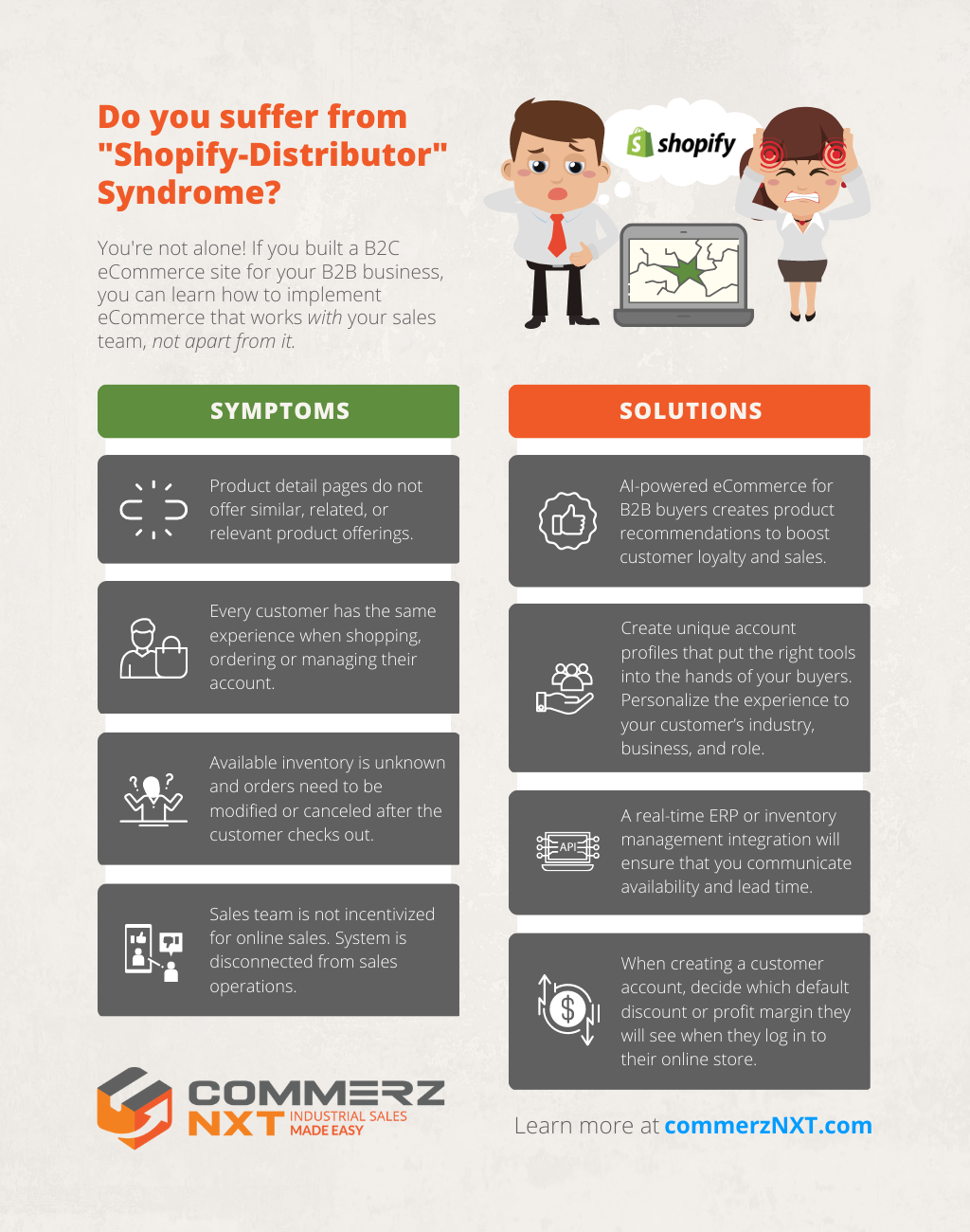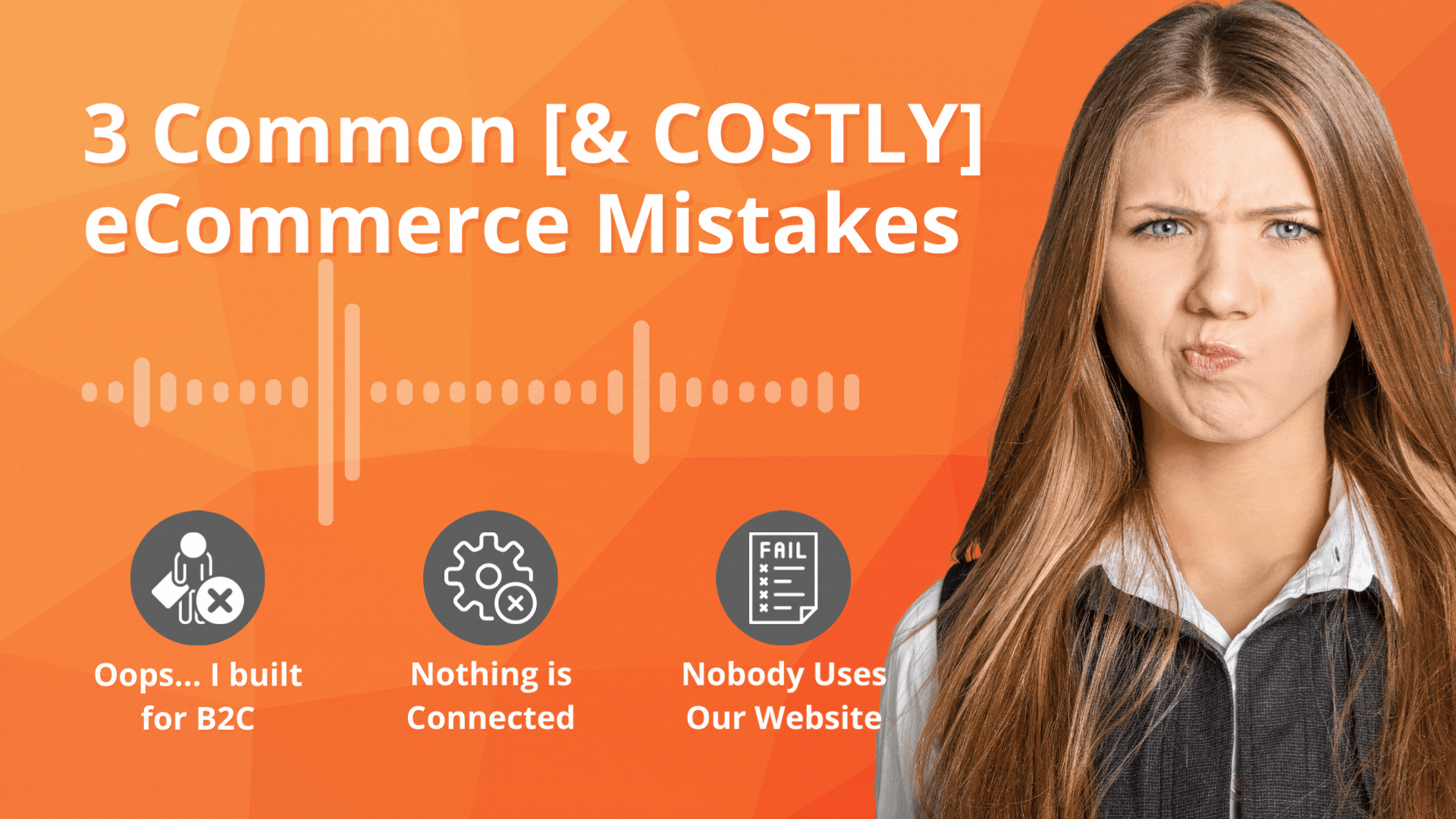Building Distributor eCommerce The Right Way: Avoid These Three [Costly] eCommerce Mistakes!
Industrial distributors are realizing the potential of an eCommerce-capable supply business but still need clarification about software, methods, and tools originally designed for B2C eCommerce.
CommerzNXT has been on the front facilitating digital transformation for industrial supply businesses. Distributors with eCommerce capabilities report that 19.7% of their sales came through digital channels in 2022. That’s compared with 14.5% in 2021 and 11.6% in 2020.
A significant jump, indeed!
So, what’s driving this transition of industrial suppliers from B2B distributors to B2B e-Distributors?
- 65% of the workforce are Millennials and Gen-Zers who are digital-first buyers and defer or avoid talking to sales
- Older generations mirrored it during the pandemic and built more confidence in online buying
- Technology tools turned into capabilities B2B buyers love
- Accurate attribution accelerated the ability to measure results
However, it’s always painful to see distributors and manufacturers alike make costly mistakes implementing eCommerce because they were advised by “someone” who may understand eCommerce, but does NOT understand industrial sales.
The most pertinent B2B eCommerce mistake is to build for the sake of having it. Further, the high intent yet lack of technical know-how often leads industrial distributors to commit 3 common eCommerce mistakes, such as
- “Oops… I built a B2C website”, platforms like WooCommerce, Shopify, or Wix may not offer a true B2B eCommerce website solution.
- “Nothing is connected”, essential eCommerce integrations with accounting and inventory software are missing, leading to compounded data issues.
- “Nobody visits our website”, lack of user adoption, starting with your sales team
Shopify-Distributor Syndrome!
You’re not alone! If you built a B2C eCommerce site for your B2B business, you can learn how to implement eCommerce that works with your sales team, not apart from it.

If anything above resonates with your eCommerce wholesale distribution business, it’s time to get it fixed.
Matt Johnson, our resident digital strategist and distributor growth expert, recently launched a 30-min podcast. You can click this link to listen to his industry insights on [costly] eCommerce mistakes to avoid. Let’s take a look at some of the key points.
🚨 MISTAKE#1: Building B2C eCommerce for B2B Buyers
| “…it’s a mistake to think of eCommerce as an independent channel… Like, here is your traditional sales business, and then over here is this other sales rep (who) does its own thing, never sleeps, is awake 24/7, selling products all the time. That’s a misunderstanding of what B2B eCommerce is … “ |
| One size does not fit all B2B businesses alike. Unlike a B2C website, a B2B eCommerce storefront is more than just a website, it’s a part of your sales team’s digital transformation process; to facilitate a better customer experience and satisfaction. |
✅ SOLUTION: Transition from B2C to B2B
Shopify Plus and others offer out-of-box solutions to power up the eCommerce experience of DTC and B2B companies. But are they effective enough for industrial suppliers?
Matt believes most out-of-box solutions may not serve the intended purpose. Industrial suppliers need tailor-made custom features to facilitate an easy transition from B2C to B2B eCommerce, such as
- Company profiles:
– Create wholesale company profiles with multiple locations and associated buyers.
- Customer accounts:
– Authenticate buyers before they can access wholesale products and pricing, and view and manage account information and order history.
- Product publishing and pricing
– Offer a personalized buying experience with curated product selections and price lists.– This includes flexible purchasing rules, percentage-based pricing, and discounts, all assigned to a specific buyer or location.
- Flexible payment options
– Creating automated net payment terms, draft orders, credit payments, vaulted cards, and invoicing to streamline the order process.
- B2B checkout
– Show wholesale pricing during accelerated checkout based on the company profile.
🚨 MISTAKE#2: Not Connecting Your ERP/CRM/PIM with B2B E-Commerce Website
| ““… there can be six-figure eCommerce website solutions getting deployed that are disconnected and therefore do not get utilized as they should … ““ |

Every business has data. Yet integrating user experiences remains a challenge for many organizations. The report finds that a lack of automation and data silos contribute to about 40% of the reasons for the failure of integration.
Unfortunately, distributor eCommerce with a complex digital ecosystem ends up with compounded data issues due to a lack of
Unfortunately, distributor eCommerce with a complex digital ecosystem ends up with compounded data issues due to a lack of back-office management and suitable eCommerce integrations.
back-office management and suitable eCommerce integrations.
The most simple form of eCommerce integration connects your Enterprise Resource Planning (ERP) system and Product Information Management (PIM) systems to the front-end of your B2B website to facilitate a rich buying experience and the transactions from it are fed to and from Customer Relational Management (CRM) software to empower your sales team for profitable up-sells and cross-sells.
✅ SOLUTION: Create Integrated User Experiences
Breakfree from the siloed approach of selling products 24/7 online using certain pricing and strict rules. Instead, create an online portal where –
- existing offline customers can access the portal
- negotiate their shopping terms
- shop items through custom product recommendations based on order history
- automate requests for proposals, check wholesale pricing on the go, and do a lot more
CommerzNXT powers your sales team by connecting an easy-to-use CRM, inventory management, sales enablement, accounting, payments features, and rich product information to create better end-user experiences.
 MISTAKE#3: Not focusing on eCommerce Adoption Among Customers and Internal Teams
MISTAKE#3: Not focusing on eCommerce Adoption Among Customers and Internal Teams
Despite investing in the right tech stake and eCommerce integrations for your industrial supplies business, your customers and even your internal sales team are not actively using your website.
More often, your sales reps are accustomed to using manufacturer or competitor websites to service customers and find it inconvenient to switch to your “new” website.
Matt identifies the innate human behavior of responding positively to external rewards to do things that might otherwise be avoided.
| Convincing someone logically to change their process to use your “perfect” B2B eCommerce website may take up to six months or more! “… perfection is the enemy of good. Taking an incremental approach to digital transformation is the key. This will help you get where you want to be without the pressure of an overnight transformation.” |
Fortunately, the solution lies in manipulating human psychology as per the Incentive theory of motivation.
The incentive theory of motivation says that humans engage in certain behaviors positively on the guarantee of external rewards and incentives, in our case, it could be special discounts for customers, additional commissions for sales reps, or branded merchandise with every order placed through the website.
But should you give up momentary margins to incentivize eCommerce adoption among your sales reps or customers?
Yes, if you have the courage to play the long game and transform your sales organization. More automation, and more self-service, means less staff for more customers. This will significantly impact your bottom line over the next few years.
✅ SOLUTION: eCommerce Adoption via Positive Incentives and Rewards
Start with a beta group of customers and an internal team to gather feedback about user experience, and sales process to make your eCommerce solution better over time for more users.
Here are a few tips to engage your beta group effectively:
- Create an incentive change or reward program
– Stronger the reward, the better the motivation for more consistent adoption of your new website.
- Develop a list of reward options
– Have a basket of incentives to choose from based on the situation or time, not just solely relying on product discounts.
– Simple rewards like a free downloadable CAD file for a product or part also work wonders.
– The 2021 Industrial Sales and Marketing Report noted 82% of engineers who download a CAD file for a part ultimately make a purchase. - Visualizing rewards is important
– The more you can “feel” what it would mean to have the reward, the more this motivates you to take the right action.
- Set realistic guidelines for receiving the reward
– Keep your guidelines realistic so they don’t stop your customers or internal team from even getting started.
– For instance, continue existing sales options for your customers with periodic nudges to make behavioral changes to adapt your website, which can be through careful content marketing or direct rewards programs.
What’s Next?
If you’re frustrated with your existing software provider or lacking in digital maturity, ask the following questions before investing in a new B2B eCommerce solution:
- How are you serving your B2B customers today?
- What would excite them based on global trends, or behavior they aren’t aware of?
- What are the key drivers, partners, and channels of your business?
- What are their processes for product requisition, quoting, and ordering purchasing?
- What are your internal requirements, restrictions, and dependencies?
And when convinced, choose a like-minded eCommerce solutions partner to build and run the show of industrial sales online successfully on your behalf.
Share this article with your network:
It's Okay to Ask for Help Sometimes
We know digital transformation can be complicated and overwhelming.
Don’t worry, we can meet you wherever you’re at and point you in the right direction.
